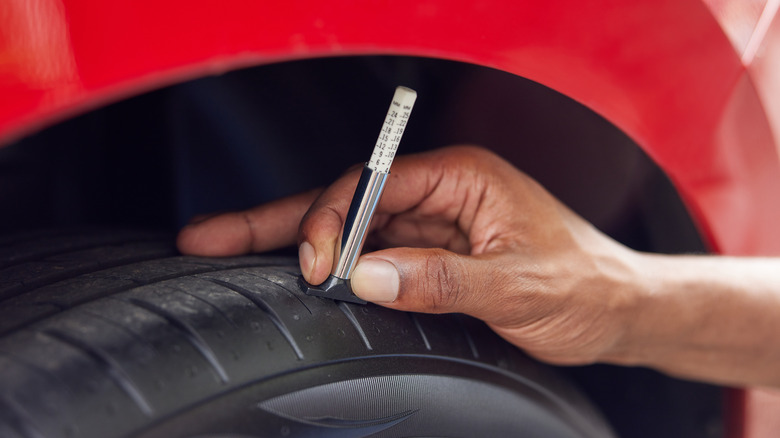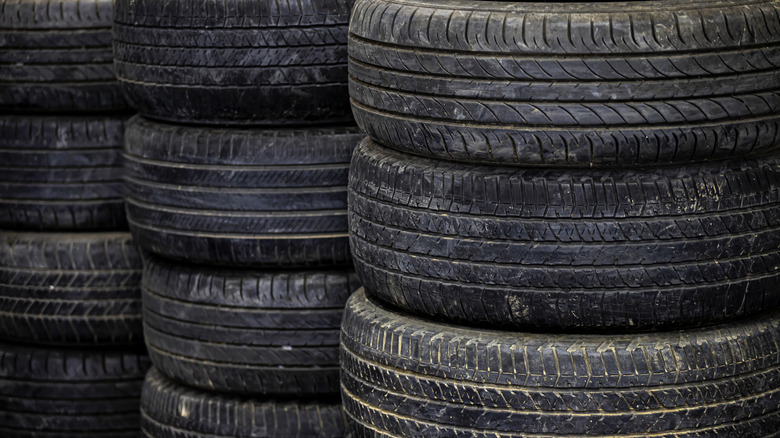
Depending on what part of the country — or world — you live in, all-wheel drive (AWD) cars can be an incredible asset. When all four wheels are powered at the same time, traction is enhanced significantly over regular two-wheel drive vehicles. Obviously, the ability to drive more safely in snow and ice makes them ideal winter vehicles, but they can also perform admirably in the sand and dirt, too. For example, it's common to find a smattering of Subaru models off-grid at hiking or mountain biking trailheads, where one might stereotypically expect to find only Jeeps or more truck-like SUVs.
If there's a hidden drawback to AWD vehicles, it's that they're particularly sensitive to all four tires being nearly identical. That's because AWD uses additional differentials compared to a two-wheel drive car. In particular, there's an extra component attached to the transmission called a transfer case. The transfer case distributes power and torque to both front and rear axles.
Such differentials are designed to tolerate brief fluctuations in wheel speed from side-to-side or front-to-back, like when making turns. However, if these components are forced to continuously process tires rolling at different speeds, high temperatures and premature wear are sure to follow. Signs to pay attention to include noises from the driveline or possible skipping or shuddering when accelerating.
 Daisy Daisy/Shutterstock
Daisy Daisy/Shutterstock
It might not be immediately obvious, but tires that are worn to varying degrees will rotate at different speeds. As tires accumulate miles, the height of the tread blocks start to diminish. For example, a tire that's used up to the point where its wear indicator bars are showing can easily be a half-inch shorter than it was originally. That means the worn tire will rotate many more times per mile than its new counterpart on the same vehicle, which stresses the AWD drivetrain.
For the same reason, drivers of AWD vehicles should also avoid mixing different brands or different model tires on their rides. In the off-road world, enthusiasts know that certain tire brands tend to run large or small versus their advertised size. Although the size difference between brands of smaller street tires may be more subtle, it's nonetheless a concern. Just because the tire size written on the sidewall is the same between two different tires doesn't mean they'll measure exactly the same diameter when scrutinized with a tape measure.
So what happens if a single tire needs to be replaced? For example, if a puncture occurs in the sidewall which isn't safe to repair? Some tire shops are equipped to "shave" new tires to match the tread thickness of the other existing tires. That might seem wasteful, but it's cheaper than buying a set of four new tires.
 Chuchart Duangdaw/Getty Images
Chuchart Duangdaw/Getty Images
The term all-wheel-drive can be misleading in a sense. While it's true that all four tires are being powered at all times, there's typically a bias between front and rear axles under normal driving conditions. For example, on dry pavement, the front axle in many modern all-wheel drive cars (excepting Subaru's Symmetrical AWD, of course) handles the majority of the engine's power. When slippery conditions are encountered, sensors convey the need for extra traction and a larger percentage of power and torque is sent to the rear wheels.
All of the above is to say that tires on the front and rear axles will wear at different rates in spite of all four tires being driven continuously to some degree. That means that AWD owners need to be vigilant about doing frequent tire rotations so the tread depth — and subsequent difference in diameter — doesn't grow too large between front and rear axles.
In summary, the best case scenario for the longevity of AWD vehicles is for all four tires to be the same brand, model, and level of wear as measured by tread depth. That said, minor variances are both inevitable and tolerated. The key word being "minor." Recommendations vary between manufacturers, so you'll want to consult your owner's manual or dealership to learn what's acceptable. In some cases, it's as little as 2/32-inch maximum difference between all tires.















Facebook Conversations